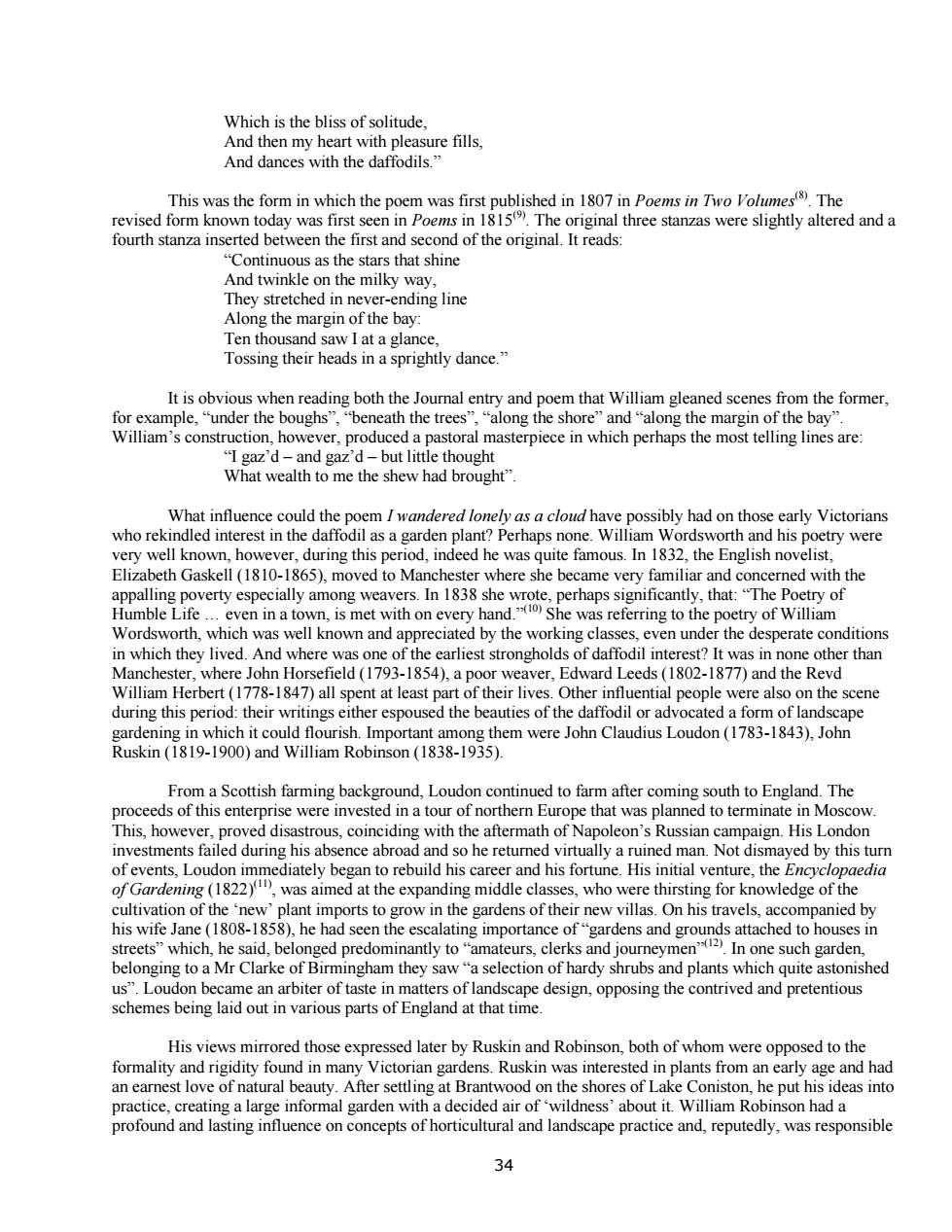
Which is the bliss of solitude. en my n This was the form in which the n was first published in 1807 in Poems in Two Volumes(s)The revised form known today was first seen in Poems in 1815)The original three stanzas were slightly altered and a fourth stanza inserted between the first and second of the original.It reads: "Continuous as the stars that shine And twinkle on the milky way, They stretched in n ending line A the margi o Ten tho htly dance.” It is obvious when reading both the Journal entry and poem that William gleaned scenes from the former for example,"under the boughs'”,“beneath the trees'”,“along the shore'”and“along the margin of the bay” William's construction,however.produced a pastoral masterpiece in which perhaps the most telling lines are: wneaz'd and gaz ough shew had brought What infl d h acloud ha ossibly had on th who rekindled int st in t ntPe am W very well known however during this period indeed he was quite famous In 1832 the English novelist were Elizabeth Gaskell(1810-1865),moved to Manchester where she became very familiar and concerned with the e was reterring to the e poetry of William Wo was w known and appreci d by the v ven un the desperate conditions h they live An 0 t strongh er thar the William Herbe during this p eir wri ither oused the beaut gardening in which it could flourish.Imr ortant among them were lohn claudius loudon (1783-1843)lobn Ruskin (1819-1900)and William Robinson (1838-1935). a Scottish farming background,Loudon cor Englan e ente were a tou vas o ous,coin ding gn.His ents loudon edia ebuild his c nd his fo His initial ver ofGardening (1822)was aimed at the expanding middle classes who were thirsting for knowledge of the cultivation of the'new'plant imports to grow in the gardens of their new villas.On his travels,accompanied by his wife Jane(1808-1858),he had seen the escalating importance of"gar rdens and groun attached to houses in streets”which, d,bele onged predominantly to ama urs,cle onging to a Mr Clarke o ngnam they sav ction o rdy shrubs and pl quite as e an arbiter oftaste in ma scape design,opposing the contrived and pretentious emes being His views mirrored those exp ssed later by Ruskin and Robinson both of whom were o oosed to the formality and rigidity found in many Victorian gardens.Ruskin was interested in plants from an early age and had an earnest love of natural beauty.After settling at Brantwood on the shores of Lake Coniston,he put his ideas into practice,creat ing a large informal garden with a decided air of'wildness'about it.William Robinson had a profound and lasting influence on concepts of horticultural and landscape practice and,reputedly,was responsible 34
34 Which is the bliss of solitude, And then my heart with pleasure fills, And dances with the daffodils.” This was the form in which the poem was first published in 1807 in Poems in Two Volumes(8). The revised form known today was first seen in Poems in 1815(9). The original three stanzas were slightly altered and a fourth stanza inserted between the first and second of the original. It reads: “Continuous as the stars that shine And twinkle on the milky way, They stretched in never-ending line Along the margin of the bay: Ten thousand saw I at a glance, Tossing their heads in a sprightly dance.” It is obvious when reading both the Journal entry and poem that William gleaned scenes from the former, for example, “under the boughs”, “beneath the trees”, “along the shore” and “along the margin of the bay”. William’s construction, however, produced a pastoral masterpiece in which perhaps the most telling lines are: “I gaz’d – and gaz’d – but little thought What wealth to me the shew had brought”. What influence could the poem I wandered lonely as a cloud have possibly had on those early Victorians who rekindled interest in the daffodil as a garden plant? Perhaps none. William Wordsworth and his poetry were very well known, however, during this period, indeed he was quite famous. In 1832, the English novelist, Elizabeth Gaskell (1810-1865), moved to Manchester where she became very familiar and concerned with the appalling poverty especially among weavers. In 1838 she wrote, perhaps significantly, that: “The Poetry of Humble Life … even in a town, is met with on every hand.”(10) She was referring to the poetry of William Wordsworth, which was well known and appreciated by the working classes, even under the desperate conditions in which they lived. And where was one of the earliest strongholds of daffodil interest? It was in none other than Manchester, where John Horsefield (1793-1854), a poor weaver, Edward Leeds (1802-1877) and the Revd William Herbert (1778-1847) all spent at least part of their lives. Other influential people were also on the scene during this period: their writings either espoused the beauties of the daffodil or advocated a form of landscape gardening in which it could flourish. Important among them were John Claudius Loudon (1783-1843), John Ruskin (1819-1900) and William Robinson (1838-1935). From a Scottish farming background, Loudon continued to farm after coming south to England. The proceeds of this enterprise were invested in a tour of northern Europe that was planned to terminate in Moscow. This, however, proved disastrous, coinciding with the aftermath of Napoleon’s Russian campaign. His London investments failed during his absence abroad and so he returned virtually a ruined man. Not dismayed by this turn of events, Loudon immediately began to rebuild his career and his fortune. His initial venture, the Encyclopaedia of Gardening (1822)(11), was aimed at the expanding middle classes, who were thirsting for knowledge of the cultivation of the ‘new’ plant imports to grow in the gardens of their new villas. On his travels, accompanied by his wife Jane (1808-1858), he had seen the escalating importance of “gardens and grounds attached to houses in streets” which, he said, belonged predominantly to “amateurs, clerks and journeymen”(12). In one such garden, belonging to a Mr Clarke of Birmingham they saw “a selection of hardy shrubs and plants which quite astonished us”. Loudon became an arbiter of taste in matters of landscape design, opposing the contrived and pretentious schemes being laid out in various parts of England at that time. His views mirrored those expressed later by Ruskin and Robinson, both of whom were opposed to the formality and rigidity found in many Victorian gardens. Ruskin was interested in plants from an early age and had an earnest love of natural beauty. After settling at Brantwood on the shores of Lake Coniston, he put his ideas into practice, creating a large informal garden with a decided air of ‘wildness’ about it. William Robinson had a profound and lasting influence on concepts of horticultural and landscape practice and, reputedly, was responsible
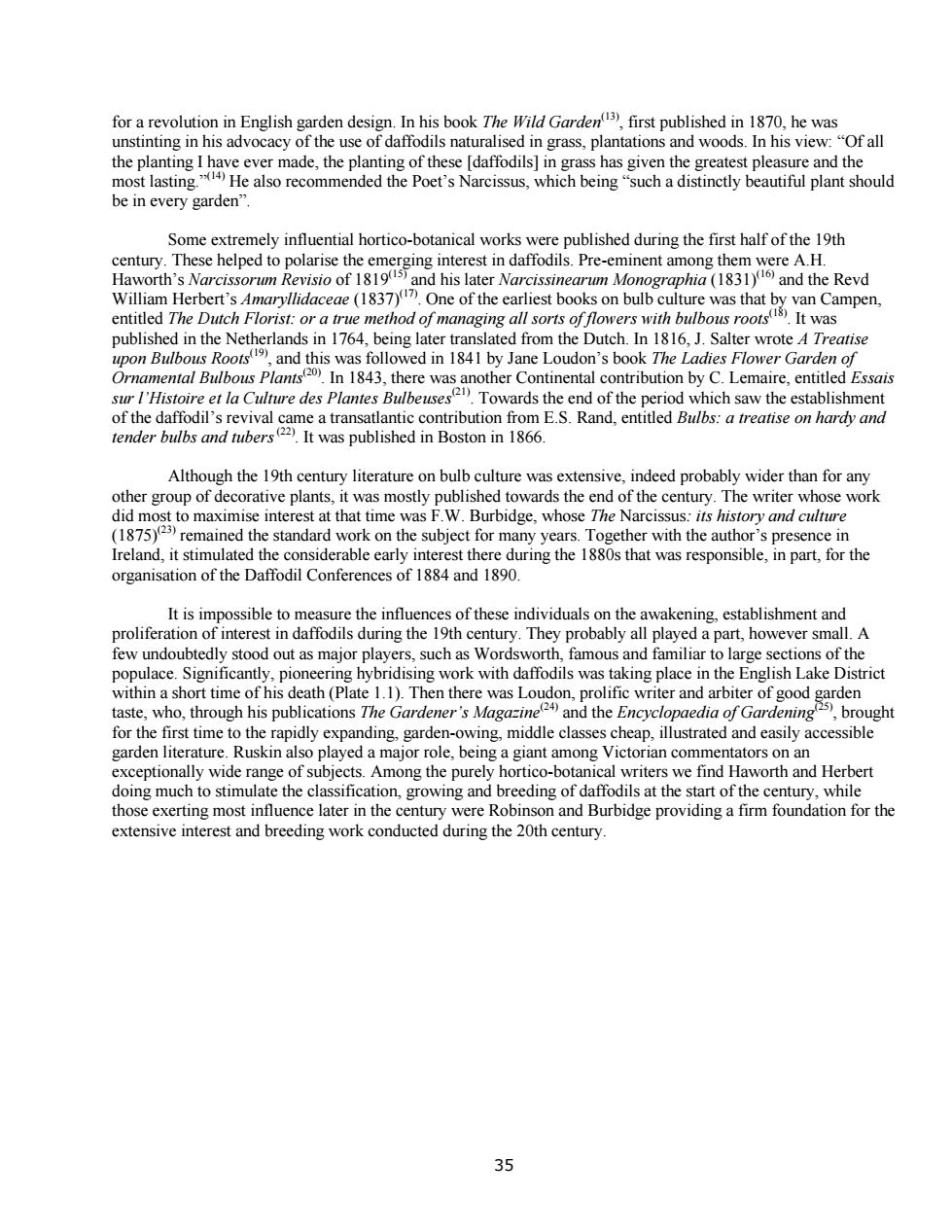
n his “Of all he nlan nting of these [daffodils] has given the and the most last "such a distinctly beautiful plant should be in every garden". Some extremely influential hortico-botanical works were published during the first half of the 19th y Ihese helped to polarise the emegingnrsdamnreA 37)zang and th f the t ho Mo e Revd mpen ed The Du with bull was t published in the Neth ands in 1764 be ing later anslated from the Dutch In 1816I Salt wrote A Tre anthisfollowed 1y Jane Loudon's ok The Ladies Floerard atise Ornamental Bulbous Plans)In 1843,there was another Continental contribution by C.Lemaire,entitled Essais sur I'Histoire et la Culture des Plantes Bulbeuses .Towards the end of the period which saw the establishment antic conributionomES.Rand,nitd Bubs:a treisenrdnd er bulbs and tubers It was published in Boston in 186 Although the 19th c ther aro of dec nlants it wrag s the nd of the did most to maximise interest at that time was FW Burbidge whose The Narcissus:is history and (1875)23)remained the standard work on the subject for many years.Together with the author's presence in Ireland,it stimulated the considerable early interest there during the 1880s that was responsible,in part,for the organisation of the Daffodil Conferences of 1884 and 1890 It is impo sible tom ure the infl vidua on the A indoubtedly stood t ac nd for s of the k with daffodils was takin Lake District hmfseath (ate D Then there was Loudon.prolific writerand arite rden taste,who,through his publications The Gardener's Magazine and the encyclopaedia of gardening 离brought for the first time to the rapidly expanding.garden-owing,middle classes cheap,illustrated and easily accessible garden literature.Ruskin also played a major role,bein ng a gi ators on ar subjects.Among the pur we nn Haworth and Herbert mg a eding o at the st infl bidg of th for the extensive inte ing the 20th century
35 for a revolution in English garden design. In his book The Wild Garden(13), first published in 1870, he was unstinting in his advocacy of the use of daffodils naturalised in grass, plantations and woods. In his view: “Of all the planting I have ever made, the planting of these [daffodils] in grass has given the greatest pleasure and the most lasting.”(14) He also recommended the Poet’s Narcissus, which being “such a distinctly beautiful plant should be in every garden”. Some extremely influential hortico-botanical works were published during the first half of the 19th century. These helped to polarise the emerging interest in daffodils. Pre-eminent among them were A.H. Haworth’s Narcissorum Revisio of 1819(15) and his later Narcissinearum Monographia (1831)(16) and the Revd William Herbert’s Amaryllidaceae (1837)(17). One of the earliest books on bulb culture was that by van Campen, entitled The Dutch Florist: or a true method of managing all sorts of flowers with bulbous roots(18). It was published in the Netherlands in 1764, being later translated from the Dutch. In 1816, J. Salter wrote A Treatise upon Bulbous Roots(19), and this was followed in 1841 by Jane Loudon’s book The Ladies Flower Garden of Ornamental Bulbous Plants(20). In 1843, there was another Continental contribution by C. Lemaire, entitled Essais sur l’Histoire et la Culture des Plantes Bulbeuses(21). Towards the end of the period which saw the establishment of the daffodil’s revival came a transatlantic contribution from E.S. Rand, entitled Bulbs: a treatise on hardy and tender bulbs and tubers(22). It was published in Boston in 1866. Although the 19th century literature on bulb culture was extensive, indeed probably wider than for any other group of decorative plants, it was mostly published towards the end of the century. The writer whose work did most to maximise interest at that time was F.W. Burbidge, whose The Narcissus: its history and culture (1875)(23) remained the standard work on the subject for many years. Together with the author’s presence in Ireland, it stimulated the considerable early interest there during the 1880s that was responsible, in part, for the organisation of the Daffodil Conferences of 1884 and 1890. It is impossible to measure the influences of these individuals on the awakening, establishment and proliferation of interest in daffodils during the 19th century. They probably all played a part, however small. A few undoubtedly stood out as major players, such as Wordsworth, famous and familiar to large sections of the populace. Significantly, pioneering hybridising work with daffodils was taking place in the English Lake District within a short time of his death (Plate 1.1). Then there was Loudon, prolific writer and arbiter of good garden taste, who, through his publications The Gardener’s Magazine(24) and the Encyclopaedia of Gardening(25), brought for the first time to the rapidly expanding, garden-owing, middle classes cheap, illustrated and easily accessible garden literature. Ruskin also played a major role, being a giant among Victorian commentators on an exceptionally wide range of subjects. Among the purely hortico-botanical writers we find Haworth and Herbert doing much to stimulate the classification, growing and breeding of daffodils at the start of the century, while those exerting most influence later in the century were Robinson and Burbidge providing a firm foundation for the extensive interest and breeding work conducted during the 20th century
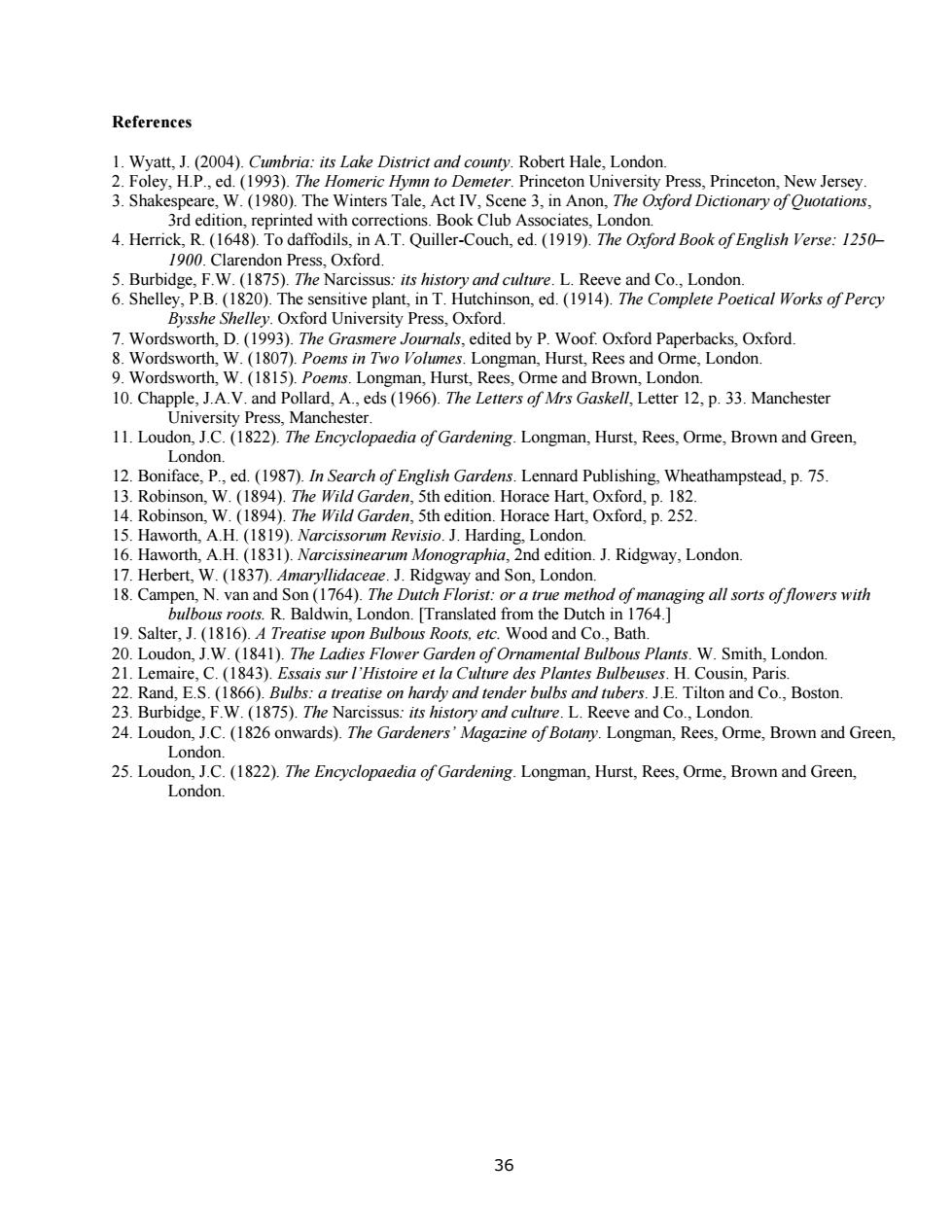
References n s Prin 3 Shake c.W.(1980).The win Act IV.Sc The Oxford Dictio 3rd edition reprinted with corrections Book Club Associates.London. 4.Herrick,R.(1648).To daffodils,in A.T.Quiller-Couch,ed.(1919).The Oxford Book of English Verse:1250- 1900.Clarendon Press,Oxford. 5.Burbidge,F.W.(1875).The Narcissus:its history and cultre.L.Reeve and Co.,London 6.Shelley,P.B.(1)The se nson,ed.(1914).The Complete Poetical Works of Percy 002 ed by P.Woof.Oxford Pap rbacks,Oxford th W/1807 P t De London 9.Wordsworth.W.(1815).Poems.Longman.Hurst.Rees.Orme and Brown.London. 10.Chapple,J.A.V.and Pollard,A..eds(1966).The Letters of Mrs Gaskell,Letter 12,p.33.Manchester University Press,Manchester. 11.Loudon,J.C.(1822).The Encyclopaedia ofGardening.Longman,Hurst,Rees,Orme,Brown and Green, ed(97) In Search of English Gardens.Lennard Publish ng.Wheathampstead.p.75 W /1904)7 race Ha Hart.Oxfor .p.252 ,p 15 Haworth A H (1810) sio.J.Harding.London 16.Haworth.A.H.(1831).Narcissinearum Monographia.2nd edition.J.Ridgway,London. 17.Herbert,W.(1837).Amaryllidaceae.J.Ridgway and Son,London. 18.Campen,N.van and Son (1764).The Dutch Florist:or a true method of managing all sorts of flowers with roots.R.Baldwin,London.[Translated from the Dutch in 1764.] nse up on Bulbous wood and Co don. The La "0e s Plants.W.Smith,L ndon Histo Boston 23.Burbidge,F.W.(1875).The Narcissus:its history and culture.L.Reeve and Co..London. 24.Loudon,J.C.(1826 onwards).The Gardeners'Magazine of Botan.Longman,Rees,Orme,Brown and Green London. 25.Loudon,J.C.(1822).The Encyclopaedia ofGardening.Longman,Hurst,Rees,Orme,Brown and Green, London. 36
36 References 1. Wyatt, J. (2004). Cumbria: its Lake District and county. Robert Hale, London. 2. Foley, H.P., ed. (1993). The Homeric Hymn to Demeter. Princeton University Press, Princeton, New Jersey. 3. Shakespeare, W. (1980). The Winters Tale, Act IV, Scene 3, in Anon, The Oxford Dictionary of Quotations, 3rd edition, reprinted with corrections. Book Club Associates, London. 4. Herrick, R. (1648). To daffodils, in A.T. Quiller-Couch, ed. (1919). The Oxford Book of English Verse: 1250– 1900. Clarendon Press, Oxford. 5. Burbidge, F.W. (1875). The Narcissus: its history and culture. L. Reeve and Co., London. 6. Shelley, P.B. (1820). The sensitive plant, in T. Hutchinson, ed. (1914). The Complete Poetical Works of Percy Bysshe Shelley. Oxford University Press, Oxford. 7. Wordsworth, D. (1993). The Grasmere Journals, edited by P. Woof. Oxford Paperbacks, Oxford. 8. Wordsworth, W. (1807). Poems in Two Volumes. Longman, Hurst, Rees and Orme, London. 9. Wordsworth, W. (1815). Poems. Longman, Hurst, Rees, Orme and Brown, London. 10. Chapple, J.A.V. and Pollard, A., eds (1966). The Letters of Mrs Gaskell, Letter 12, p. 33. Manchester University Press, Manchester. 11. Loudon, J.C. (1822). The Encyclopaedia of Gardening. Longman, Hurst, Rees, Orme, Brown and Green, London. 12. Boniface, P., ed. (1987). In Search of English Gardens. Lennard Publishing, Wheathampstead, p. 75. 13. Robinson, W. (1894). The Wild Garden, 5th edition. Horace Hart, Oxford, p. 182. 14. Robinson, W. (1894). The Wild Garden, 5th edition. Horace Hart, Oxford, p. 252. 15. Haworth, A.H. (1819). Narcissorum Revisio. J. Harding, London. 16. Haworth, A.H. (1831). Narcissinearum Monographia, 2nd edition. J. Ridgway, London. 17. Herbert, W. (1837). Amaryllidaceae. J. Ridgway and Son, London. 18. Campen, N. van and Son (1764). The Dutch Florist: or a true method of managing all sorts of flowers with bulbous roots. R. Baldwin, London. [Translated from the Dutch in 1764.] 19. Salter, J. (1816). A Treatise upon Bulbous Roots, etc. Wood and Co., Bath. 20. Loudon, J.W. (1841). The Ladies Flower Garden of Ornamental Bulbous Plants. W. Smith, London. 21. Lemaire, C. (1843). Essais sur l’Histoire et la Culture des Plantes Bulbeuses. H. Cousin, Paris. 22. Rand, E.S. (1866). Bulbs: a treatise on hardy and tender bulbs and tubers. J.E. Tilton and Co., Boston. 23. Burbidge, F.W. (1875). The Narcissus: its history and culture. L. Reeve and Co., London. 24. Loudon, J.C. (1826 onwards). The Gardeners’ Magazine of Botany. Longman, Rees, Orme, Brown and Green, London. 25. Loudon, J.C. (1822). The Encyclopaedia of Gardening. Longman, Hurst, Rees, Orme, Brown and Green, London
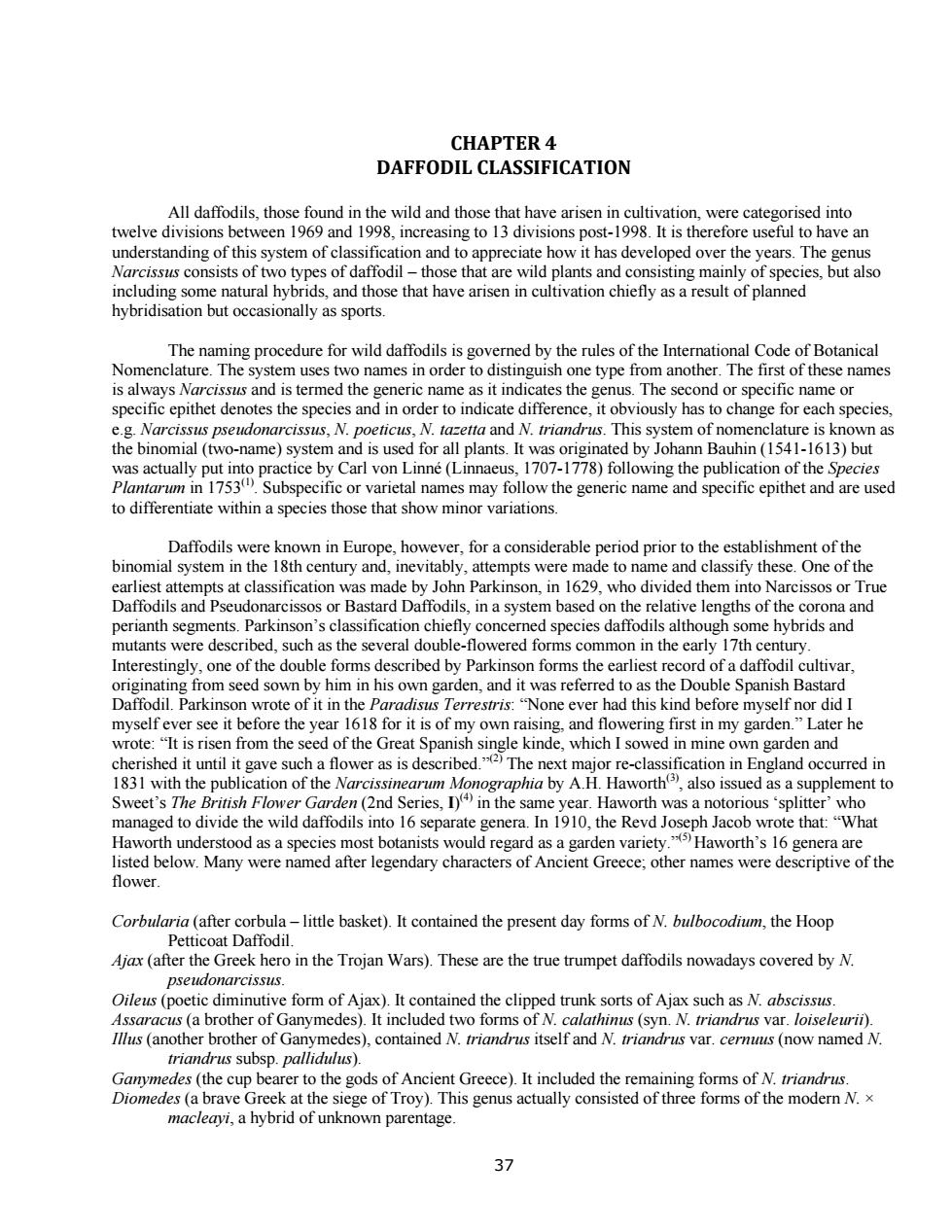
CHAPTER 4 DAFFODIL CLASSIFICATION all daffodils those found in the wild and those that have arisen in cultivation.were categorised into twelve divisions between 1969 and 1998,increasing to 13 divisions post-1998.It is therefore useful to have an understanding of this system of classification and to appreciate how it has developed over the years.The genus Narcissus consists of two types of daffodil-those that are wild plants and consisting mainly of species,but also including some natural hyb ids,and those that have arisen in cultivation chiefly as a result of planned nybridisation but occasionally as sports The nam wild daffodils is ed hu the rulee ofthe Int rnational Code of Botanical uish o e from another.The first of these names is always Narcissus and is termed the generic name as it indicates the genus.The second or specific name or specific epithet denotes the species and in order to indicate difference,it obviously has to change for each species. e.g.Narcissus pseudonarcissus,N.poeticus,N.tazetta and N.triandrus.This system of nomenclature is known as the binomial (two-name)system and is use d for al plants.It was originate by Johann B uhin(1541-1613)but 70 778)1 ollowing the pub vithin a species sho names may foll the generic name and spe are use Daffodils were known in Furone however for a considerable neriod nrior to the establishment of the binomial system in the 18th century and,inevitably,attempts were made to name and classify these.One of the earliest attempts at classification was made by John Parkinson,in 1629,who divided them into Narcissos or True Daffodils and Pseudonarcissos or Bastard Daffodils.in a system based on t e relative lengths of the corona and perianth segments.P n s cla conce ed species daffo is alth ugh some hybrids and tants we re d one of nd i Doubl Daffodil.Parkinso ote of it in the paradisus terrestris "None ever had this kind before myself nor did i myself ever see it before the year 1618 for it is of my own raising.and flowering first in my garden."Later he cherishedhsed of the Great Spanish single kinde.which I sowed in mine own garden and 1831 with the pub ation of the Narciss earum Mo ,also issued as a supplement to n the same was a notorious 'spli nag divide hat: Vha th's l were p med after ndary chara An nt gn ther name the flower Corbularia(after corbula-little basket).It contained the present day forms of N.bulbocodium,the Hoop Petticoat Da Ajax(aft Greek hero in the Trojan Wars).These are the true trumpet daffodils nowadays covered by N 人 d )It ained th orts of Aj a b d Illus (another brother of Gany medes).contained N.triandrus itself and N.riandrus var.cermuus (now named N triandrus subsp.pallidulus). Ganymedes(the cup bearer to the gods of Ancient Greece).It included the remaining forms of N.triandrus. Diomedes(a brave Greck at the siege of Troy).This genus actually consisted of three forms of the modern N.x macleavi,a hybrid of unknown parentage. 37
37 CHAPTER 4 DAFFODIL CLASSIFICATION All daffodils, those found in the wild and those that have arisen in cultivation, were categorised into twelve divisions between 1969 and 1998, increasing to 13 divisions post-1998. It is therefore useful to have an understanding of this system of classification and to appreciate how it has developed over the years. The genus Narcissus consists of two types of daffodil – those that are wild plants and consisting mainly of species, but also including some natural hybrids, and those that have arisen in cultivation chiefly as a result of planned hybridisation but occasionally as sports. The naming procedure for wild daffodils is governed by the rules of the International Code of Botanical Nomenclature. The system uses two names in order to distinguish one type from another. The first of these names is always Narcissus and is termed the generic name as it indicates the genus. The second or specific name or specific epithet denotes the species and in order to indicate difference, it obviously has to change for each species, e.g. Narcissus pseudonarcissus, N. poeticus, N. tazetta and N. triandrus. This system of nomenclature is known as the binomial (two-name) system and is used for all plants. It was originated by Johann Bauhin (1541-1613) but was actually put into practice by Carl von Linné (Linnaeus, 1707-1778) following the publication of the Species Plantarum in 1753(1). Subspecific or varietal names may follow the generic name and specific epithet and are used to differentiate within a species those that show minor variations. Daffodils were known in Europe, however, for a considerable period prior to the establishment of the binomial system in the 18th century and, inevitably, attempts were made to name and classify these. One of the earliest attempts at classification was made by John Parkinson, in 1629, who divided them into Narcissos or True Daffodils and Pseudonarcissos or Bastard Daffodils, in a system based on the relative lengths of the corona and perianth segments. Parkinson’s classification chiefly concerned species daffodils although some hybrids and mutants were described, such as the several double-flowered forms common in the early 17th century. Interestingly, one of the double forms described by Parkinson forms the earliest record of a daffodil cultivar, originating from seed sown by him in his own garden, and it was referred to as the Double Spanish Bastard Daffodil. Parkinson wrote of it in the Paradisus Terrestris: “None ever had this kind before myself nor did I myself ever see it before the year 1618 for it is of my own raising, and flowering first in my garden.” Later he wrote: “It is risen from the seed of the Great Spanish single kinde, which I sowed in mine own garden and cherished it until it gave such a flower as is described.”(2) The next major re-classification in England occurred in 1831 with the publication of the Narcissinearum Monographia by A.H. Haworth(3) , also issued as a supplement to Sweet’s The British Flower Garden (2nd Series, I) (4) in the same year. Haworth was a notorious ‘splitter’ who managed to divide the wild daffodils into 16 separate genera. In 1910, the Revd Joseph Jacob wrote that: “What Haworth understood as a species most botanists would regard as a garden variety.”(5) Haworth’s 16 genera are listed below. Many were named after legendary characters of Ancient Greece; other names were descriptive of the flower. Corbularia (after corbula – little basket). It contained the present day forms of N. bulbocodium, the Hoop Petticoat Daffodil. Ajax (after the Greek hero in the Trojan Wars). These are the true trumpet daffodils nowadays covered by N. pseudonarcissus. Oileus (poetic diminutive form of Ajax). It contained the clipped trunk sorts of Ajax such as N. abscissus. Assaracus (a brother of Ganymedes). It included two forms of N. calathinus (syn. N. triandrus var. loiseleurii). Illus (another brother of Ganymedes), contained N. triandrus itself and N. triandrus var. cernuus (now named N. triandrus subsp. pallidulus). Ganymedes (the cup bearer to the gods of Ancient Greece). It included the remaining forms of N. triandrus. Diomedes (a brave Greek at the siege of Troy). This genus actually consisted of three forms of the modern N. × macleayi, a hybrid of unknown parentage
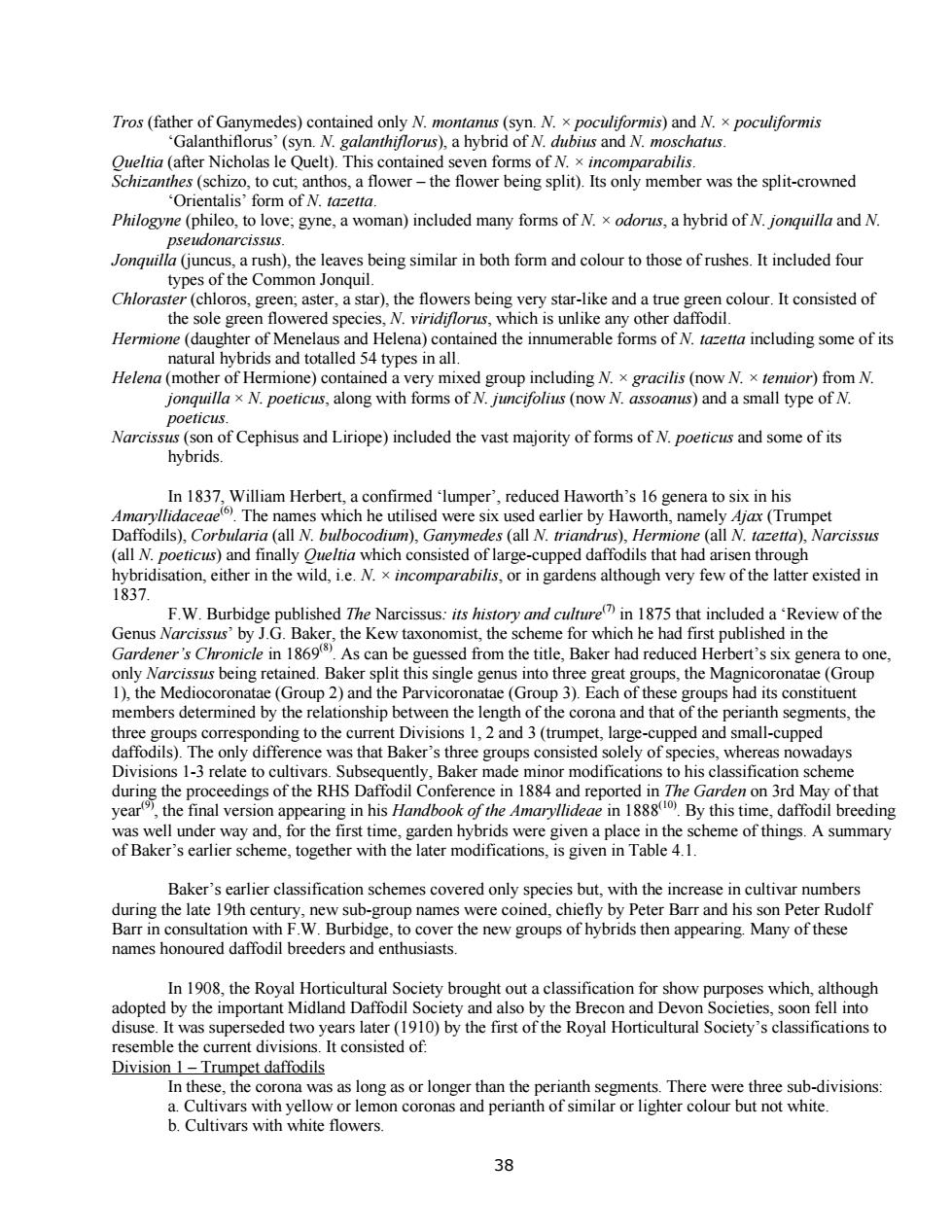
syn. r sle e ontaine seven for wer being split).Its onby member was thesp/ ntalis'form of N Philogyne (phileo,to love:gyne,a woman)included many forms of N.x odorus,a hybrid of N.jonquilla and N. pseudonarcissus Jonguilla(juncus,a rush),the leaves being similar in both form and colour to those of rushes.It included four types of the Common Jonquil. Chloraster (chloros,green,aster,a star),the flo ers being very star r-like and a true green colour.It consisted of spe Hermione(da a)c rs the etta including some of its rids 0 ey之adr)》 ow N.a issoanus)and a small type of N. poeticus Narcissus(son of Cephisus and Liriope)included the vast majority of forms of N.poericus and some of its hybrids. liam Herbert,a s16 genera to six in his Daffodils).Corbula h G des (all N tr (all N.poericus)and finally which consisted of large-cupped daffodils that had arisen through hybridisation,either in the wild,i.e.N.x incomparabilis,or in gardens although very few of the latter existed in 1837 F.W.Burbidge published The Narcissus:that inc a'Review of the Ge nus Narcissus'by taxonom heme d in the ner's Ch s can b d from th Baker had reduced 's six genera to one ingle gen th ups.the members determined by the relati onship between the length of the corona and that of the perianth segments,the three grouns corres onding to the current Divisions 1 2 and 3 (trumpet large. -cupped and small-cupped daffodils).The only difference was that Baker's three groups consisted solely of species,whereas nowadays Divisions I-3 relate to cultivars.Subsequently,Baker made minor modifications to his classification schem eedings of the RHS Da nce in 1884 report May of tha n appe daffodil breeding st things.A summary Baker's earlier classification schemes covered only species but,with the increase in cultivar numbers during the late 19th century,new sub-group names were coined,chiefly by Peter Barr and his son Peter Rudolf Barr in consultati ion with F.W.Burbidge,to cover the new groups of hybrids then appearing Many of these names honoured daffodil breeders and enthusiasts In 1908,the R iety brought out for show purpo ses which,althou ugh y th rs later (1910 al Soci 。lassificati0 s to resemble the current divisions it consisted of Division 1-Trumpet daffodils In these,the corona was as long as or longer than the perianth segments.There were three sub-divisions: a.Cultivars with yellow or lemon coronas and perianth of similar or lighter colour but not white. b.Cultivars with white flowers
38 Tros (father of Ganymedes) contained only N. montanus (syn. N. × poculiformis) and N. × poculiformis ‘Galanthiflorus’ (syn. N. galanthiflorus), a hybrid of N. dubius and N. moschatus. Queltia (after Nicholas le Quelt). This contained seven forms of N. × incomparabilis. Schizanthes (schizo, to cut; anthos, a flower – the flower being split). Its only member was the split-crowned ‘Orientalis’ form of N. tazetta. Philogyne (phileo, to love; gyne, a woman) included many forms of N. × odorus, a hybrid of N. jonquilla and N. pseudonarcissus. Jonquilla (juncus, a rush), the leaves being similar in both form and colour to those of rushes. It included four types of the Common Jonquil. Chloraster (chloros, green; aster, a star), the flowers being very star-like and a true green colour. It consisted of the sole green flowered species, N. viridiflorus, which is unlike any other daffodil. Hermione (daughter of Menelaus and Helena) contained the innumerable forms of N. tazetta including some of its natural hybrids and totalled 54 types in all. Helena (mother of Hermione) contained a very mixed group including N. × gracilis (now N. × tenuior) from N. jonquilla × N. poeticus, along with forms of N. juncifolius (now N. assoanus) and a small type of N. poeticus. Narcissus (son of Cephisus and Liriope) included the vast majority of forms of N. poeticus and some of its hybrids. In 1837, William Herbert, a confirmed ‘lumper’, reduced Haworth’s 16 genera to six in his Amaryllidaceae(6). The names which he utilised were six used earlier by Haworth, namely Ajax (Trumpet Daffodils), Corbularia (all N. bulbocodium), Ganymedes (all N. triandrus), Hermione (all N. tazetta), Narcissus (all N. poeticus) and finally Queltia which consisted of large-cupped daffodils that had arisen through hybridisation, either in the wild, i.e. N. × incomparabilis, or in gardens although very few of the latter existed in 1837. F.W. Burbidge published The Narcissus: its history and culture(7) in 1875 that included a ‘Review of the Genus Narcissus’ by J.G. Baker, the Kew taxonomist, the scheme for which he had first published in the Gardener’s Chronicle in 1869(8). As can be guessed from the title, Baker had reduced Herbert’s six genera to one, only Narcissus being retained. Baker split this single genus into three great groups, the Magnicoronatae (Group 1), the Mediocoronatae (Group 2) and the Parvicoronatae (Group 3). Each of these groups had its constituent members determined by the relationship between the length of the corona and that of the perianth segments, the three groups corresponding to the current Divisions 1, 2 and 3 (trumpet, large-cupped and small-cupped daffodils). The only difference was that Baker’s three groups consisted solely of species, whereas nowadays Divisions 1-3 relate to cultivars. Subsequently, Baker made minor modifications to his classification scheme during the proceedings of the RHS Daffodil Conference in 1884 and reported in The Garden on 3rd May of that year(9), the final version appearing in his Handbook of the Amaryllideae in 1888(10). By this time, daffodil breeding was well under way and, for the first time, garden hybrids were given a place in the scheme of things. A summary of Baker’s earlier scheme, together with the later modifications, is given in Table 4.1. Baker’s earlier classification schemes covered only species but, with the increase in cultivar numbers during the late 19th century, new sub-group names were coined, chiefly by Peter Barr and his son Peter Rudolf Barr in consultation with F.W. Burbidge, to cover the new groups of hybrids then appearing. Many of these names honoured daffodil breeders and enthusiasts. In 1908, the Royal Horticultural Society brought out a classification for show purposes which, although adopted by the important Midland Daffodil Society and also by the Brecon and Devon Societies, soon fell into disuse. It was superseded two years later (1910) by the first of the Royal Horticultural Society’s classifications to resemble the current divisions. It consisted of: Division 1 – Trumpet daffodils In these, the corona was as long as or longer than the perianth segments. There were three sub-divisions: a. Cultivars with yellow or lemon coronas and perianth of similar or lighter colour but not white. b. Cultivars with white flowers